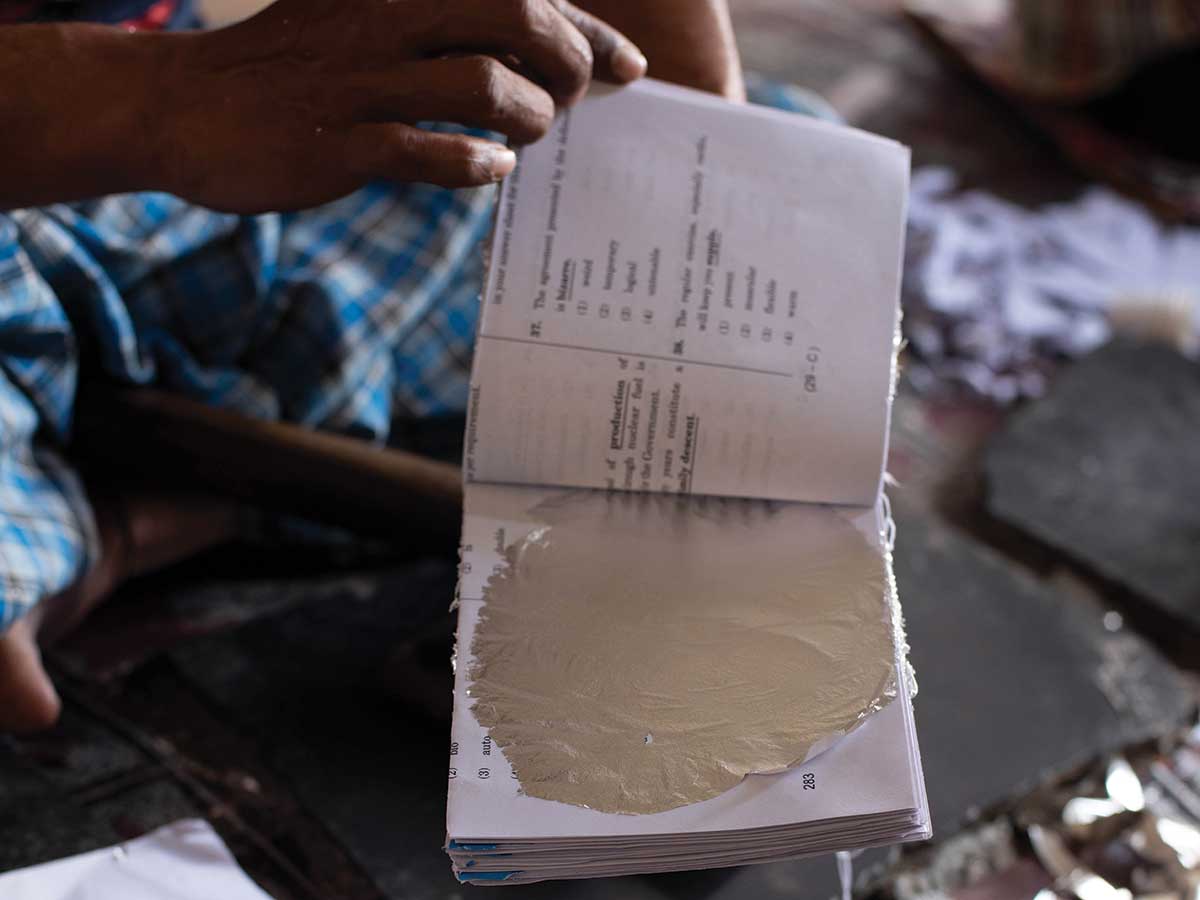
In Hyderabad, India, A Tradition of Silver-Lined Sweets Endures
Called “warq,” the edible silver foil is still made by hand in the streets of Charminar
You hear them long before you see them. The lanes off Charminar, the sepia-toned arch in Old City that defines Hyderabad's skyline, pulse with the energy of thousands of people on a thousand missions: some browsing for bangles, others dealing delicate crystal bottles of ittar perfume, many simply searching for a good plate of biryani. But if you listen closely, amid the honking rickshaws and entreaties of women bargaining for lace, you can hear a measured beat: tak-tak-tak-tak, tak-tak-tak-tak.
In a handful of workshops—most so tiny that you'd miss them entirely if you sneezed while walking past—workers hammer at slender, nondescript booklets, creating a percussive clattering. All day long, karigars, or artisans, pound cubes of silver into warq, the whisper-thin silver leaf traditionally draped on dishes in Hyderabad and beyond. These shimmering veils were long a fixture atop both sweets and savories, with gossamer flakes cast over heaving platters of biryani, qorma, and shahi tukda—literally "royal piece," a famously decadent bread pudding.
Some credit Persian hakeems, or doctors, with introducing the tradition centuries ago; others say its roots are homegrown, inspired by Ayurvedic medicine, with the delicate metals doled out as a salve for everything from infertility and depression to memory loss and indigestion. The practice thrived in the royal courts of Delhi and Lucknow in the 19th century, and soon, influences from North and South India, Central Asia, Persia, and Turkey commingled in the royal kitchens of the Nizam of Hyderabad, where gold leaf was considered an aphrodisiac, and silver was valued for its antibacterial properties.
In a princely state such as Hyderabad—the seventh Nizam, Mir Osman Ali Khan, who was anointed the wealthiest man in the world in a Time cover story in 1937, used the 185-carat Jacob diamond as a paperweight—blinged-out food was as important as a blinged-out desk. The decadence of the state was apparent even on the dinner plate. "The big entertainment was food—the food was so beautiful," says Javed Akbar, a Hyderabadi food historian who developed the culinary program at the city's opulent new ITC Kohenur hotel. "On a rich man's table, warq was a kind of presentation, to make food look richer, more attractive." After India gained its independence in 1947, however, and princes were stripped of their powers and dominions as the country transitioned toward democracy, the ensuing decades also saw a decline in extravagantly garnished foods.
Today, you can still find warq on desserts such as badam ki jaali, an almond cookie that's a staple in Hyderabadi sweet shops; qubani ka meetha, an apricot pudding; barfi, a milk-based confection; and India's beloved betelnut snack, paan. But warq's ubiquity has diminished, and is more often relegated to elaborate wedding dishes. "Now the use is very rare," says Akbar. "The people have forgotten about it. The nawabs have gone, the raja-maharaja days are over."
The dwindling popularity of the trade is evident near the Charminar, where warq workshops once numbered in the dozens and now just a handful remain. “They all closed up,” a shopkeeper laments. “There’s no business left.” The introduction of machines that dramatically reduce both the time and cost of producing warq are somewhat to blame, as they’re edging out the artisanal competition from the karigars. But the machines aren’t transforming the business; they’re merely eating into what’s left of it: As impure imposters laced with aluminum or nickel enter the market, people are becoming wary of the quality of the warq they’re consuming. “Those with the machines are giving us a bad name,” one shopkeeper tells me in Urdu. “If they give us a bad name, their business increases.” What’s more, a void of wealthy patronage has caused a dwindling interest in carrying on the centuries-old tradition. Religious undercurrents might play a role too, with the current political climate fomenting tensions between Hindus and Muslims, the latter of whom dominate the handmade trade.
Tiny warq operations, such as Charminar Warq Shop, MA Warq, Ittehad Warq, and UTC Leaf, are still plying their wares, and the karigars continue to help set the rhythm for the city’s soundtrack. The volume has decreased in recent years, both in numbers and noise, but the beat goes on—for now.
Keep Reading
Continue to Next Story










